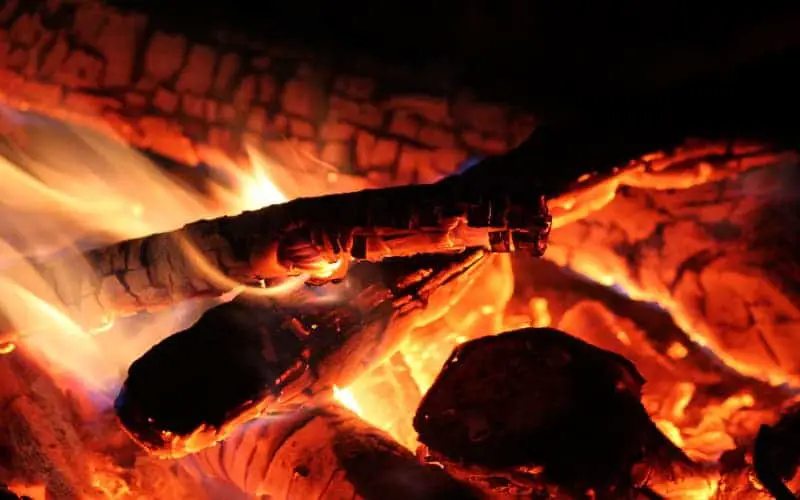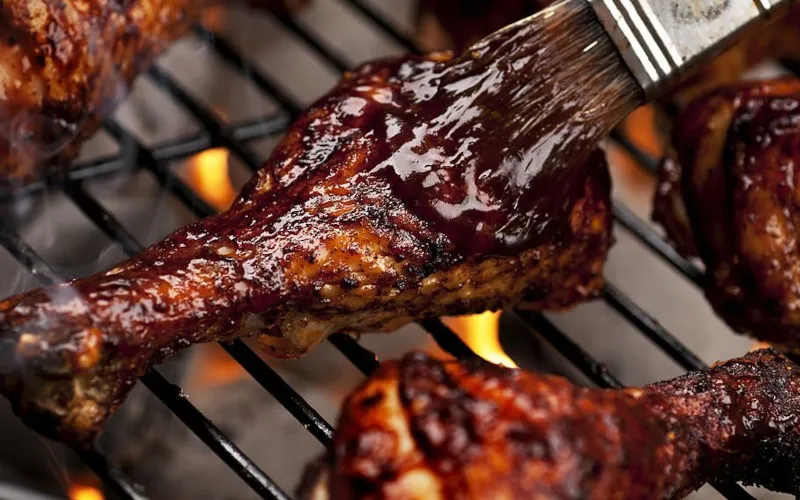Bacon is delicious, but getting it wrong can be frustrating, especially when the family’s breakfast depends on your getting it right. We’ve created this helpful guide to knowing when bacon is done to perfection every time you cook it.
You can use this guide when making delicious bacon on the stove, oven, or wherever! We’ll even help you know what to do with that crispy fat left behind once you remove the bacon from the pan.
With our easy step-by-step instructions, you can never go wrong with bacon again.
How to Tell When Bacon is Done?
Most people find that their bacon is done when it reaches a certain internal temperature. However, you can also tell if your bacon is done using several other visual tricks.
Here are some ways to know if your bacon is done:
1. Color
Bacon is considered properly cooked when it changes color from pink to brown. The degree of doneness will depend on how you like your bacon. If you prefer crispy bacon, you’ll want to cook it until it turns a dark brown.
For a softer texture, stop cooking before your bacon reaches that point.
Either way, look for a uniform golden brown color on both sides of your bacon, not just one side. If you have multiple strips, make sure they’re all done at once to avoid rotating them during cooking (which can cause uneven cooking).
2. Texture
Another way to tell if your bacon is done is by feeling its texture. It should be firm and not squishy or soft in any way. If you feel a slight give, then it’s still cooking.
If you press down on it with your finger, there shouldn’t be any indentation left behind when you take it away. This means that it’s ready to eat.
3. Sizzle Sound
If you place a piece of raw bacon into a frying pan, it will sizzle as soon as it hits the hot surface. However, if your bacon is already cooked, it won’t make any noise when placed in a frying pan. This can be an easy way to tell if your bacon is done without touching or looking at it. You’ll know right away if your bacon is ready to eat.
4. Shape
Once your bacon is cooked, you’ll notice it begins to curl. Once it curls up into a circle, then it’s done. At that point, you can flip your bacon and cook it on its other side. If you don’t want to end up with a mess of curled-up bacon strips, make sure not to overcook them.
If they start curling before they are finished cooking, remove them from heat for about 5 minutes and let them cool down. Then continue cooking until they are done.
5. Internal Temperature
You can tell if your bacon is done using a meat thermometer. Cooked bacon should reach an internal temperature of 155 to 165 degrees Fahrenheit.
Make sure that your bacon reaches at least 160 degrees Fahrenheit before eating. This will make sure it’s safe to eat and also tastes delicious!
6. Time guide
Last but not least, if you don’t have any other ways to determine whether or not your bacon is cooked properly, use time as a guide. For example, if you cook three strips of bacon on medium heat for 20 minutes, all three strips should be cooked by that point.
If they aren’t cooked yet, increase your heat slightly or leave them in longer until they are finished cooking.
Related: Pork Belly vs Bacon
How Long Does it Take to Cook Bacon?
If you’re looking for a precise cooking time, plan on approximately 10 minutes of cooking time per side. Depending on how hot your stovetop or cooking equipment is, it could take 8 to 12 minutes per side.
It’s always safer to cook your bacon in shorter bursts of time – keep an eye on it after 4 or 5 minutes and check it as needed. If one side seems to be browning faster than another, flip your slices over halfway through.
Methods for Cooking Bacon
Once you’ve picked out a package of bacon, you have to decide how you want to cook it.
Here are a few popular methods for cooking bacon:
Note, however, that the best method for cooking bacon will depend on your tastes and how much of a hurry you’re in.
Method 1: The Skillet
Try to fry your bacon on a pan or skillet if you have time to spare. This produces evenly cooked pieces that are easy to turn as they crisp up.
And if you make sure to grease your pan thoroughly with an oil-soaked paper towel, your bacon will taste great, but cleanup will be minimal.
Method 2: The Microwave
If you’re in a hurry and don’t want to deal with hot grease splattering everywhere, then go for cooking your bacon in the microwave instead of using an oven or stovetop method.
It takes about five to ten minutes, but it produces evenly cooked pieces that are crisp on all sides. Just be sure to observe it so that it doesn’t burn.
Method 3: The Oven
If you want even more control over your bacon’s crispness, then bake the bacon in an oven at 375 degrees Fahrenheit for about 15 minutes.
This will give you evenly cooked pieces that are easy to turn as they crisp up—and cleanup is as simple as throwing away a paper towel once everything is done.
Method 4: The Broiler
If you’re planning on cooking multiple packages of bacon at once, then consider using your oven’s broiler function instead of its regular bake setting. This will allow you to cook a ton of bacon in a very short amount of time without worrying about it getting too dark or burnt. Just be sure to observe it so that it doesn’t burn.
Method 5: The Stovetop
In this option, you can go with frying your bacon on a stovetop. This requires a lot of supervision, so it’s better if you only fry one or two pieces at a time. Turn your burner onto medium heat and set your pan over it for about seven minutes on each side.
It would help if you turned it once every minute or so. If you don’t, you run a greater risk of burnt bacon. This method does produce evenly cooked bacon that’s easy to turn over as it crisps up.
Method 6: Cooking in the Smoker/Grill
If you’re looking for a way to make bacon even more mouthwatering than it already is, try smoking or grilling it. This produces smoky and delicious bacon that’s great as an appetizer or a side dish. If you go with grilling it, be sure to have your grill set at 350 degrees Fahrenheit so that your bacon doesn’t burn before it cooks through.
Method 7: Cooking in Water
The final way to cook bacon is by simmering it in a pot of water. This can help you achieve evenly cooked and easy-to-eat bacon pieces without risking burnt bits.
However, make sure that you keep an eye on it so that it doesn’t get too soggy. If it’s just not working out, consider using a different method instead.
Is it Safe to Consume Undercooked Bacon?
While most pork parts can be eaten raw, it’s not a good idea to eat undercooked bacon. Bacon comes from the bottom part of a pig which harbors bacteria. That’s why it’s a good idea to check for doneness. The FDA recommends cooking all meat until it reaches an internal temperature of 160 degrees Fahrenheit (71 degrees Celsius).
Consuming undercooked bacon may cause foodborne illness and even death. The main concern with consuming undercooked bacon is that it could contain Trichinella spiralis, a parasitic roundworm that causes trichinosis.
It’s important to note that freezing does not kill Trichinella spiralis; therefore, freezing your bacon will not make it safe to consume raw or undercooked.
Is Too Much Bacon Bad for Your Health?
New research indicates that eating bacon daily could increase your risk of death from heart disease and cancer. The problem seems to be nitrates found in bacon and other processed meats that are converted into harmful chemicals when ingested.
Also called sodium nitrite, these preservatives prevent the meat from spoiling and contribute to high blood pressure and damage blood vessels, both of which lead to an increased risk of heart attack or stroke. Nitrates may also increase the production of carcinogens (cancer-causing agents) during digestion.
Bacon contains a lot of saturated fats and cholesterol that have been linked to heart disease.
Research has shown that people who eat bacon every day have a higher risk of developing heart disease than those who don’t eat it at all. And while you may think one or two slices won’t hurt you, studies show that eating even small amounts of processed meats can be dangerous for your health.
Frequently Asked Questions
Can Bacon Be Air Fried?
Yes, it can. If you haven’t heard of air frying before, allow us to give you a quick rundown on how it works. Air frying uses convection heat and circulates hot air to cook food in minutes. While air fryers don’t use any oil or butter, they still manage to crisp up food like a pro.
You might be wondering why we should choose an air fryer over traditional cooking methods. For starters, cooking with an air fryer is incredibly fast – most recipes take about 10-15 minutes from start to finish!
It also helps your kitchen stay cool, and your house doesn’t smell like bacon for days after you make some. And if all that wasn’t enough, many models are small enough to fit on your countertop, so they won’t take up much space.
Does Bacon Smoke When You Cook It?
Well, yes and no. If you’re cooking bacon in a pan on your stovetop, some smoke will be involved. However, if you’re using an air fryer for cooking your bacon, there won’t be any smoke.
This is because air fryers use circulating hot air to cook food instead of direct heat as pans do.
How Long Does It Take To Cook Bacon At 350?
This depends on how you want your bacon. If you want soft, crispy bacon, cook it for 18 minutes at 350 degrees Fahrenheit. If you want hard and crunchy bacon, cook it for 22 minutes at 350 degrees Fahrenheit. Well, there’s a reason for that. Cook times vary depending on what type of cooker you have.
How Long Does It Take To Cook Bacon At 425?
On average, you should cook bacon at 425 degrees Fahrenheit for about 15 minutes if you want it to be soft and floppy. If you’re cooking hard, crunchy bacon, cook it for 20 minutes at 425 degrees Fahrenheit.
Once again, these are just estimates, so your specific cooking time may vary! It all depends on what type of cooker you have and what thickness and cut of bacon you use.
Why is My Bacon Turning White?
If you’re using an air fryer for cooking your bacon, you might notice that it turns white towards the end of cooking. This is a good thing! The sugar in your bacon gets super concentrated as it cooks, and once it reaches a specific temperature, it will start to turn white.
That doesn’t mean you should stop cooking, though – give your bacon a few extra minutes in an air fryer, and watch how quickly it changes back to its original color.
How Long Can Raw Bacon Sit Out?
Generally, raw bacon cannot sit up for more than 2 hours at room temperature. If you leave it out any longer than that, you risk botulism poisoning.
Conclusion
There are many indicators to tell if bacon is done cooking. These include looking at the color, listening for sounds, and checking the temperature with a thermometer. How you tell when bacon is done will depend on your preference and style of cooking.
But after reading about different techniques, it’s up to you to decide which best suits your needs. Be sure not to undercook or overcook your bacon; it won’t taste as good.
Undercooking is even harmful because it can lead to foodborne illness. While overcooked bacon may be dry and tough, that doesn’t mean you should cook more than necessary. After all, there’s no need to waste food!





